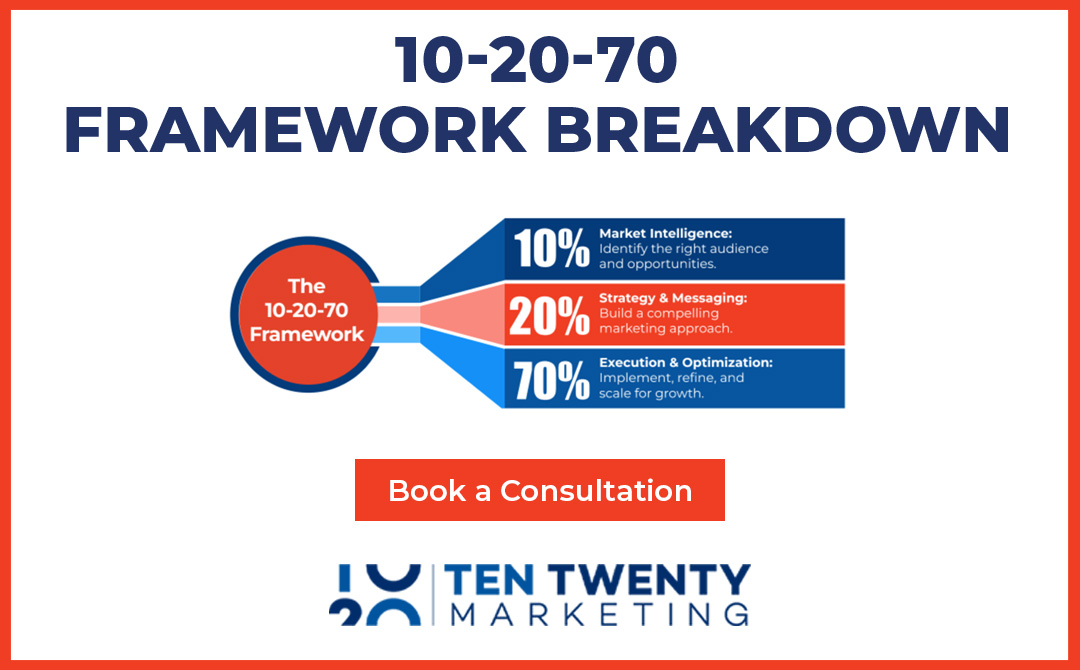Every industrial company we work with eventually asks the same question:
“How do we get marketing and sales to actually work together?”
It’s a good question — and an urgent one. Because if your marketing is filling the pipeline with unqualified leads or disconnected content, your sales team tunes it out. On the flip side, if sales is flying solo without air cover from marketing, you’re leaving real revenue on the table.
We created the 10-20-70 Framework to solve that.
It’s our internal model for building marketing programs that don’t just look good — they support sales activity, scale your brand, and drive better-fit opportunities into your inbox.
Here’s what it looks like in action.
The Breakdown: 10% Strategy, 20% Infrastructure, 70% Execution
Let’s start with the numbers:
- 10% Strategy
This is where we define your ideal customer, your positioning, your funnel, your goals. It’s not just “who are we targeting?” — it’s what do we stand for, what pain point do we solve, and how do we prove it better than anyone else?
It’s also where we get executive buy-in. If leadership doesn’t believe in the plan, it won’t get the resources it needs to succeed.
20% Infrastructure
This is the marketing foundation most industrial suppliers lack. It includes CRM structure, tracking and analytics, landing pages, SEO baselines, a social content engine, and shared sales enablement tools.
If you skip this part, you’ll always feel like your marketing is disjointed or hard to measure.
- 70% Execution
This is where content gets made, ads get launched, videos get posted, and conversations get started. It’s the visible work — but it only performs if the first 30% is in place.
Without clear strategy or smart infrastructure, all that execution becomes noise.
Why This Framework Works
It gives the right weight to the hard stuff.
Most companies want to jump to execution. But that’s like building a factory without engineering drawings or utilities. You can do it — but you’re going to hit expensive problems fast.
By carving out just 10% of your marketing effort for high-leverage strategy and 20% for infrastructure, you actually make the other 70% more effective.
Better inputs, better outputs.
How It Aligns Sales and Marketing
Here’s how 10-20-70 fixes the sales/marketing gap:
- Sales is part of the strategy phase — so the ICP (Ideal Customer Profile) reflects real-world conversations
- Infrastructure includes shared CRM (Customer Relationship Management) and data insights — so sales sees what’s working
- Execution maps to funnel stages — so content actually supports deal progression
The end result:
Sales gets better conversations. Marketing gets better results. Leadership gets clearer ROI (Return On Investment).
What Happens Without It
If you skip the framework?
- Strategy becomes siloed or ad hoc
- Marketing becomes disconnected from sales priorities
- Execution becomes reactive and resource-draining
- No one knows what’s working or why
Sound familiar?
It’s not that your team isn’t trying. It’s that they’re working without a system.
How to Start Using It
You don’t need to launch a massive initiative to apply 10-20-70 thinking.
Start small:
- Allocate time for true strategy sessions each quarter
- Audit your marketing infrastructure — where are the cracks?
- Build content and campaigns that directly support sales conversations
Think of it as a mindset shift, not a formula. The point isn’t the percentages. The point is balance.
Final Thoughts
If you’re stuck in a cycle of disconnected campaigns, unclear results, or strained sales-marketing dynamics — it’s probably not a tactics problem.
It’s a system problem.
The 10-20-70 Framework brings clarity, accountability, and focus to the way you market. And for industrial companies, that clarity is everything.
Because when your marketing machine hums like your production line, business flows better.

